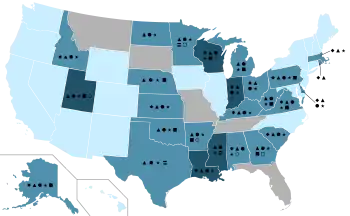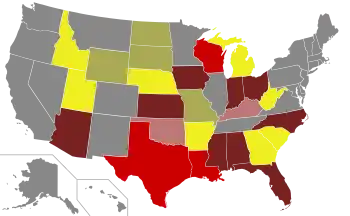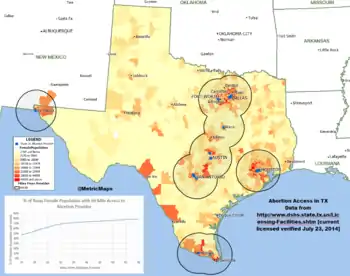Abortion in the United States by state
Abortion in the United States is legal via the landmark 1973 case of Roe v. Wade, the first abortion case to be taken to the Supreme Court. Specifically, abortion is legal in all U.S. states, and every state has at least one abortion clinic.[1][2] However, individual states can regulate/limit the use of abortion or create "trigger laws", which would make abortion illegal within the first and second trimesters if Roe were overturned by the Supreme Court of the United States[3][4][5] Also, nine states—Alabama, Arizona, Arkansas, Michigan, Mississippi, New Mexico, Oklahoma, West Virginia and Wisconsin still have their unenforced pre-Roe abortion bans on the lawbooks, which could start being enforced if Roe were overturned.[4] In accordance with the US Supreme Court case of Planned Parenthood v. Casey (1992), states cannot place legal restrictions posing an undue burden for "the purpose or effect of placing a substantial obstacle in the path of a woman seeking an abortion of a nonviable fetus."[6]
Current legal status nationwide


2 Massachusetts' parental consent law only applies to minors under the age of 16. South Carolina's law only apples to minors under 17.




The current judicial interpretation of the US Constitution regarding abortion in the United States, following the Supreme Court of the United States 1973 landmark decision in Roe v. Wade, and subsequent companion decisions, is that abortion is legal but may be restricted by the states to varying degrees. States have passed laws to restrict late term abortions, require parental notification for minors, and mandate the disclosure of abortion risk information to patients prior to the procedure.[7]
The key, deliberated article of the US Constitution is the Fourteenth Amendment, which states that:
All persons born or naturalized in the United States, and subject to the jurisdiction thereof, are citizens of the United States and of the State wherein they reside. No State shall make or enforce any law which shall abridge the privileges or immunities of citizens of the United States; nor shall any State deprive any person of life, liberty, or property, without due process of law; nor deny to any person within its jurisdiction the equal protection of the laws.[8]
The official report of the US Senate Judiciary Committee, issued in 1983 after extensive hearings on the Human Life Amendment (proposed by Senators Orrin Hatch and Thomas Eagleton), stated:
Thus, the [Judiciary] Committee observes that no significant legal barriers of any kind whatsoever exist today in the United States for a woman to obtain an abortion for any reason during any stage of her pregnancy.[9]
One aspect of the legal abortion regime now in place has been determining when the fetus is "viable" outside the womb as a measure of when the "life" of the fetus is its own (and therefore subject to being protected by the state). In the majority opinion delivered by the court in Roe v. Wade, viability was defined as "potentially able to live outside the woman's womb, albeit with artificial aid. Viability is usually placed at about seven months (28 weeks, approx. 196 days) but may occur earlier, even at 24 weeks." When the court ruled in 1973, the then-current medical technology suggested that viability could occur as early as 24 weeks. Advances over the past three decades have allowed fetuses that are a few weeks less than 24 weeks old to survive outside the woman's womb. These scientific achievements, while life-saving for premature babies, have made the determination of being "viable" somewhat more complicated. The youngest child thought to have survived a premature birth in the United States was Amillia Taylor (born on 24 October 2006 in Miami, Florida, at 21 weeks and 6 days gestational age, approx. 153 days vs. possibly expected gestational period of 40 weeks, approx. 280 days).[10]
In comparison to other developed countries, the procedure is more available in the United States in terms of how late the abortion can legally be performed. However, in terms of other aspects such as government funding, privacy for non-adults, or geographical access, some US states are far more restrictive. In most European countries abortion on-demand is allowed only during the first trimester, with abortions during later stages of pregnancy being allowed only for specific reasons (e.g. physical or mental health reasons, risk of birth defects, if the woman was raped etc.). The reasons that can be invoked by a woman seeking an abortion after the first trimester vary by country, for instance, some countries, such as Denmark, provide a wide range of reasons, including social and economic ones.[11]
There are no laws or restrictions regulating abortion in Canada, while the law on abortion in Australia varies by state/territory. In many countries the right to abortion has been legalized by respective parliaments, while in the US the right to abortion has been deemed a part of a constitutional right to privacy by the Supreme Court.
Because of the split between federal and state law, legal access to abortion continues to vary somewhat by state. Geographic availability, however, varies dramatically, with 87 percent of US counties having no abortion provider.[12] Moreover, due to the Hyde Amendment, many state health programs which poor women rely on for their health care do not cover abortions; currently only 17 states (including California, Illinois and New York) offer or require such coverage.[13]
The 1992 case of Planned Parenthood v. Casey overturned Roe's strict trimester formula, but reemphasized the right to abortion as grounded in the general sense of liberty and privacy protected under the Due Process Clause of the Fourteenth Amendment to the United States Constitution: "If the right of privacy means anything, it is the right of the individual, married or single, to be free from unwarranted governmental intrusion into matters so fundamentally affecting a person as the decision whether to bear or beget a child." Advancements in medical technology meant that a fetus might be considered viable, and thus have some basis of a right to life, at 22 or 23 weeks rather than at the 28 that was more common at the time Roe was decided. For this reason, the old trimester formula was ruled obsolete, with a new focus on viability of the fetus.
Since 1995, led by Congressional Republicans, the US House of Representatives and US Senate have moved several times to pass measures banning the procedure of intact dilation and extraction, also commonly known as partial birth abortion. After several long and emotional debates on the issue, such measures passed twice by wide margins, but President Bill Clinton vetoed those bills in April 1996 and October 1997 on the grounds that they did not include health exceptions. Congressional supporters of the bill argue that a health exception would render the bill unenforceable, since the Doe v. Bolton decision defined "health" in vague terms, justifying any motive for obtaining an abortion. Subsequent Congressional attempts at overriding the veto were unsuccessful.
On October 2, 2003, with a vote of 281–142, the House again approved a measure banning the procedure, called the Partial-Birth Abortion Ban Act. Through this legislation, a doctor could face up to two years in prison and face civil lawsuits for performing such an abortion. A woman who undergoes the procedure cannot be prosecuted under the measure. The measure contains an exemption to allow the procedure if the woman's life is threatened.
On October 21, 2003, the United States Senate passed the same bill by a vote of 64–34, with a number of Democrats joining in support. The bill was signed by President George W. Bush on November 5, 2003, but a federal judge blocked its enforcement in several states just a few hours after it became public law. The Supreme Court upheld the nationwide ban on the procedure in the case Gonzales v. Carhart on April 18, 2007. The 5-4 ruling said the Partial-Birth Abortion Ban Act does not conflict with previous Court decisions regarding abortion.
The decision marked the first time the court allowed a ban on any type of abortion since 1973. The swing vote, which came from moderate justice Anthony Kennedy, was joined by Justices Antonin Scalia, Clarence Thomas, and the two recent appointees, Samuel Alito and Chief Justice John Roberts.
State regulatory initiatives regarding abortion

The following states have or had initiatives regarding abortion. The fetal heartbeat bill legislative approach has picked up momentum in 2018 and 2019.
Alabama
House Bill 490 prohibiting abortions once a heartbeat is detected passed the Lower House (73-29) on March 4, 2014. Alabama was the first state to pass such a bill.[14] The bill later died in committee.[15]
On April 2, 2019, House Bill 314, also known as the Human Life Protection Act, which bans abortions at every stage of pregnancy and criminalizes the procedure for doctors (except in the case of medical emergency), was introduced into the Lower House. The bill passed the Lower House on April 30 (74-3),[16] the Senate on May 14,[17] and was signed into law by Governor Kay Ivey on May 16.[18]
Alaska
Arizona
Arkansas
California
Colorado
The initiative was proposed jointly by Kristine Burton and Michael Burton[19] of Colorado for Equal Rights.[20] Colorado Amendment 48 was a proposed initiative to amend the definition of a person to "any human being from the moment of fertilization." On November 4, 2008, the initiative was turned down by 73.2 percent of the voters.[21]
Connecticut
The 1821 abortion law of Connecticut is known to be the first legal action that was passed within America to restrict reproductive rights of American Women.
Although this law did not completely outlaw abortions, it placed heavier restrictions as it prevented women from attempting or receiving abortions, which was generally through the consumption of poison, during the first four months of a woman's pregnancy.
Delaware
District of Columbia
The District of Columbia has no law with respect to abortion. The previous statute making abortion a criminal offense was repealed in 2004. The consequence of this repeal is that abortion is completely unregulated in the District throughout the period of pregnancy.
Florida
Georgia
Georgia passed an abortion law on May 7, 2019 which prohibits abortions after a fetal heartbeat is detected; usually when a woman is six weeks pregnant. The law makes no exception for cases of rape or incest.[22] The constitutionality of the law was challenged by the American Civil Liberties Union, Planned Parenthood, and the Center for Reproductive Rights. In October 2019, the federal judge overseeing the case blocked enforcement of the ban, which was to take effect in January 2020, stating that the plaintiffs have shown a likelihood of winning the case.[23]
Hawaii
Idaho
Illinois
Indiana
Iowa
As of April 2020, abortion was legal in Iowa. On March 26, 2020, Governor Kim Reynolds expanded upon previous COVID-19 disaster proclamations to halt elective and non-essential surgeries.[24] The following day her office asserted: "[The] Proclamation suspends all nonessential or elective surgeries and procedures until April 16th, that includes surgical abortion procedures".[25]
UPDATE
As of 1/27/2021 The Iowa House passed a constitutional amendment that says Iowans do not have the fundamental right to abortion or public funding for it.
Kansas
Kansas lawmakers approved sweeping anti-abortion legislation (HB 2253) on April 6, 2013 that says life begins at fertilization, forbids abortion based on gender and bans Planned Parenthood from providing sex education in schools.[26]
In 2015 Kansas became the first state to ban the dilation and evacuation procedure, a common second-trimester abortion procedure.[27] But the new law was later struck down by the Kansas Court of Appeals in January 2016 without ever having gone into effect.[28] In April 2019, the Kansas Supreme Court affirmed the lower court's decision, and ruled that the right to abortion is inherent within the state's constitution and bill of rights, such that even if Roe v. Wade is overturned and the federal protection of abortion rights is withdrawn, the right would still be allowed within Kansas, barring a change in the state constitution.[29]
Kentucky
Louisiana
On June 19, 2006, Governor Kathleen Blanco signed into law a trigger ban on most forms of abortion (unless the life of the mother was in danger or her health would be permanently damaged) once it passed the state legislature. Although she felt exclusions for rape or incest would have "been reasonable," she felt she should not veto based on those reasons. The trigger law would only go into effect if the United States Supreme Court reversed Roe v. Wade. Louisiana's measure would allow the prosecution of any person who performed or aided in an abortion. The penalties include up to 10 years in prison and a maximum fine of $100,000.[30]
A second law, Act 620, passed in 2014, modeled after one passed earlier in Texas, required that any doctor performing abortions also have admittance privileges at an authorized hospital within a 30-mile radius of the abortion clinic, among other new requirements. At the time the law was passed, only one doctor had this privileges, effectively leaving only one legal abortion clinic in the state.[31] Ultimately, the model Texas law was declared unconstitutional by the Supreme Court in Whole Woman's Health v. Hellerstedt in 2016, as the additional admitting privileges required by Texas law interfered with a woman's right to an abortion per Roe v. Wade.[32] While the Texas law was being challenged, the Louisiana law was challenged by abortion clinics and doctors in the state in June Medical Services, LLC v. Gee; while the District Court ordered an injunction on the law, the Fifth Circuit Appeals Court reversed this decision, allowing the law to come in effect later in 2014. The plaintiffs petitioned the Supreme Court, who granted an emergency stay of the Fifth Circuit's order, pending the result of the pending Texas litigation in Whole Woman's Health. June Medical Services was remanded back to District Court, which found the law unconstitutional under Whole Woman's Health. The Fifth Circuit reversed the District's finding and prepared to allow the law to come back into effect by February 4, 2019, differentiating the case from the Texas one as they found the physician had not taken any steps to try to qualify for this allowance. The plaintiffs again petitioned the Supreme Court for an emergency stay of the Fifth Circuit's decision.[33] Justice Samuel Alito granted the stay of the law until February 7, 2019, stating that the Court needed more time to evaluate the request and had made no merits on the ruling of the case.[34] Subsequently, on February 7, 2019, the Supreme Court ruled 5–4, with Justice John Roberts joining the liberal Justices, in reversing the Firth Circuit's order, effectively preventing the law from going into effect.[35]
Maine
Maryland
Massachusetts
Michigan
Minnesota
Mississippi
On February 27, 2006, Mississippi's House Public Health Committee voted to approve a ban on abortion, but that bill died after the House and Senate failed to agree on compromise legislation.[36]
On November 8, 2011, the Personhood amendment, to define personhood as beginning "at the moment of fertilization, cloning, or the functional equivalent thereof," was rejected by 55 percent of voters.[37]
On March 20, 2018, a federal district court in Mississippi enacted a temporary, 10-day ban of the enforcement of a new state law that prohibits the performance of an abortion once the gestational age of the fetus is greater than 15 weeks.[38][39][22]
Missouri
Montana
Nebraska
Nevada
New Hampshire
New Jersey
New Mexico
New York
North Carolina
North Dakota
Ohio
An Ohio state law passed in April 2019 will make abortion illegal after the fetus's heartbeat can be detected, usually between five or six weeks into the pregnancy. No exceptions for cases of rape or incest are made in the law, which is slated to go into effect in July.[22]
Oklahoma
In 2016, Oklahoma state legislators passed a bill to criminalize abortion for providers, potentially charging them with up to three years in prison.[40] On May 20, 2016, Governor Mary Fallin vetoed the bill before it could become law, citing its wording as too vague to withstand a legal challenge.[41]
Oregon
Pennsylvania
Rhode Island
South Carolina
South Dakota
In 2004, a bill outlawing abortion passed both houses of the legislature, but was vetoed by the Governor due to a technicality. The state's legislature subsequently passed five laws curtailing the legality of abortion in 2005.[42] The majority of a legislative "task force"[43] then issued a report recommending that the Legislature illegalize all abortions, which would lead to a challenge of the constitutionality of Roe v. Wade in the United States Supreme Court. A separate minority report criticizing the process and reaching different conclusions was also released.[44]
In February 2006, the Legislature passed the Women's Health and Human Life Protection Act, which was signed into law by Governor Mike Rounds on March 6, 2006. This law would have forbidden abortion under virtually every circumstance, including in cases of rape and incest. The law allowed "a medical procedure designed or intended to prevent the death of a pregnant mother." Physicians performing such procedures would have been required to "...make reasonable medical efforts under the circumstances to preserve both the life of the mother and the life of her unborn child."
The act had specifically defined pregnancy as beginning at the point of conception rather than at implantation into the uterine wall (see beginning of pregnancy controversy), which might have meant that WHHLPA applied to emergency contraception and possibly all forms of hormonal contraception.
A referendum to repeal the Women's Health and Human Life Protection Act was placed on ballot for the November 2006 statewide election due to a successful petition drive by the organization South Dakota Healthy Families. On May 30, over 38,000 petition signatures were filed, more than twice the 17,000 required to place a measure on the ballot. On November 7, WHHLPA was repealed by the South Dakota electorate; the vote was 56%-44% favoring repeal.[45]
Tennessee
Texas

The Roe v. Wade case, tried in Texas, stands at the center of years of national debate about the issue of abortion.[46] Henry Wade was serving as District Attorney of Dallas County at the time.
On August 29, 2014 US District Judge Lee Yeakel struck down as unconstitutional two provisions of Texas' omnibus anti-abortion bill, House Bill 2 that was to come into effect on September 1. The regulation would have closed about a dozen abortion clinics, leaving only eight places in Texas to get a legal abortion, all located in major cities. Judge Lee Yeakel ruled that the state's regulation was unconstitutional and would have placed an undue burden on women, particularly on poor and rural women living in west Texas and the Rio Grande Valley.[47] The legal challenge to the law eventually reached the Supreme Court in Whole Woman's Health v. Hellerstedt (2016) which ruled that the law was unconstitutional, its burden of requiring abortion doctors to have admission privileges at a local hospital within 30 miles of the center to interfere with a woman's right to an abortion from Roe v. Wade.
Utah
Vermont
Virginia
Washington
West Virginia
Wisconsin
In 2013, Act 37 was passed into law, necessitating admitting privileges for all abortion providers within the state. Admitting privileges allow physicians the right to directly admit a patient to a nearby hospital. The state maintained this was necessary for women's health and safety, however, public health officials and the medical community - including the American College of Gynecologists and Obstetricians, Wisconsin Medical Society, and American Public Health Association - oppose these requirements as unnecessary and are not grounded in evidence-based practice.[48] Not only are these privileges difficult for abortion physicians to obtain given the controversial nature of abortion, the Wisconsin law required admitting privileges to be obtained within one day of the law's passage. After Governor Walker signed the bill into law, a federal district court judge in the Western District of Wisconsin immediately granted a preliminary injunction, preventing its implementation. A trial was held, and the court imposed a permanent injunction against the law, with the Judge noting that clinic closure was clearly the purpose of the law as there was only one day granted for physicians to obtain compliance. Further, the ruling found that abortion complications "are rare and are rarely dangerous", thus it seems to undermine the argument that this law is needed for women's health and safety.[49]
The case was appealed by the state's attorney, yet the US Seventh Circuit Court of Appeals upheld the earlier ruling, and the permanent injunction. The appeals court declared, as did the trial court judge, that the state had failed to demonstrate any obvious need for this legislation.[50] The state further appealed to the Supreme Court, however, this appeal was rejected, maintaining the permanent injunction of the law. The rejection by the Supreme Court to hear the case came rather quickly after the ruling in the state of Texas' case also involving admitting privileges. The Supreme Court's ruling in Whole Women's Health v. Hellerstedt found that the admitting privileges requirement created an undue burden for women, and thus interfered with the rights established in Roe v. Wade.
Wyoming
State table
Bans of abortion
| State | Current legality | Status before "Roe" | Current status | ||
|---|---|---|---|---|---|
| Legal status in 2020 | Completely illegal | Illegal with limits | Trigger law on any abortion | Trigger law on late term abortion | |
| legal | Yes | Yes* | Yes | Yes | |
| legal | No | No | Yes | Yes | |
| legal | Yes | Yes* | Yes | Yes | |
| legal | Yes | Yes* | No | Yes | |
| legal | No | Yes* | No | No | |
| legal | No | Yes* | Yes | No | |
| legal | No | No | No | No | |
| legal | No | Yes | No | No | |
| legal | No | Yes* | No | Yes | |
| legal | No | Yes* | No | No | |
| legal | No | No | No | No | |
| legal | Yes | No | No | Yes | |
| legal | Yes | No | No[51] | No[51] | |
| legal | Yes | No | No | Yes | |
| legal | Yes | No | No | Yes | |
| legal | Yes | No | No | Yes | |
| legal | Yes | No | No | Yes | |
| legal | Yes | No | Yes | Yes | |
| legal | No | No | No | No | |
| legal | No | Yes* | No | No | |
| legal | No | Yes* | No | No | |
| legal | Yes | No | No | Yes | |
| legal | Yes | No | No | No | |
| legal | No | Yes* | No | Yes | |
| legal | Yes | No | Yes | Yes | |
| legal | Yes | No | No | No | |
| legal | Yes | No | No | Yes | |
| legal | Yes | No | No | No | |
| legal | Yes | No | No | No | |
| legal | Yes | No | No | Yes | |
| legal | No | Yes* | No | No | |
| legal | No | No | No | No | |
| legal | No | Yes* | No | No | |
| legal | Yes | No | No | Yes | |
| legal | Yes | No | Yes | Yes | |
| legal | Yes | No | Yes | Yes | |
| legal | No | Yes* | No | No | |
| legal | Yes | No | No | No | |
| legal | Yes | No | No | Yes | |
| legal | No | Yes* | No | Yes | |
| legal | Yes | No | No | Yes | |
| legal | Yes | No | Yes | Yes | |
| legal | Yes | No | No | No | |
| legal | Yes | No | Yes | Yes | |
| legal | Yes | No | No | No | |
| legal | No | Yes* | Yes | Yes | |
| legal | No | No | No | No | |
| legal | Yes | No | No | Yes | |
| legal | Yes | No | No | Yes | |
| legal | Yes | No | No | No | |
Limits on abortion
| State | Time limit without exceptions[52] | Waiting period | Mandatory ultrasound[53] | Counseling | % of counties without provider [54] | Parental Notification for Minors | Parental Consent for Minors[55] |
|---|---|---|---|---|---|---|---|
| Yes | Yes | Yes | 59% | No | One | ||
| None | None | No | Yes | 37% | No | No | |
| Viability | Yes | 24 hours | Yes | 19% | No | One | |
| 20 weeks | Yes | No | Yes | 77% | No | One | |
| Viability | None | No | None | 5% | No | No | |
| None | None | No | None | 27% | Yes[56] | No | |
| Viability | None | No | None | 5% | No | No | |
| Viability | None | No | Yes | 33% | Yes | No | |
| 24 weeks | None | Yes | None | 20% | Yes | No | |
| Yes | No | Yes | 58% | Yes | No | ||
| Viability | None | No | None | 5% | No | No | |
| Viability | Yes | No | Yes | 68% | No | One [57] | |
| Viability | None | No | None | 40% | Yes | No | |
| 20 weeks | Yes | No | Yes | 66% | No | One | |
| 20 weeks | None | No | None | 42% | Yes | No | |
| 20 weeks | Yes | Yes | Yes | 56% | No | One | |
| Yes | Yes | Yes | 74% | No | One | ||
| 20 weeks | Yes | 24 hours[58] | Yes | 63% | No | One | |
| Viability | None | No | None | 55% | No | No | |
| Viability | None | No | None | 24% | Yes | No | |
| 24 weeks | None | No | Yes | 14% | No | One | |
| Viability | Yes | No | Yes | 40% | No | One | |
| Viability | Yes | No | Yes | 59% | Yes | No | |
| 20 weeks | Yes | Yes | Yes | 91% | No | Both | |
| Viability | Yes | No | Yes | 94% | No | Both | |
| Viability | None | No | None | 55% | No | No | |
| 20 weeks | Yes | No | Yes | 41% | No | One | |
| 24 weeks | None | No | None | 9% | No | No | |
| None | None | No | None | 30% | Yes | No | |
| None | None | No | None | 23% | No | No | |
| None | None | No | None | 48% | No | No | |
| Viability or 24 weeks[59] | None | No | None | 10% | No | No | |
| 20 weeks | None | No | None | 53% | No | One | |
| 20 weeks | Yes | No | Yes | 73% | Yes | Both | |
| Viability | Yes | No | Yes | 56% | No | One | |
| 20 weeks | Yes | No | Yes | 54% | Yes | One | |
| None | None | No | None | 30% | No | No | |
| 24 weeks | Yes | No | Yes | 48% | No | One | |
| 24 weeks | None | No | Yes | 36% | No | One | |
| 20 weeks | Yes | No | Yes | 71% | No | One | |
| 20 weeks | None | No | None | 77% | Yes | No | |
| Viability | None | No | None | 63% | No | One | |
| 20 weeks | Yes | 24 hours | Yes | 43% | Yes | One | |
| Viability | Yes | No | Yes | 62% | Yes | One | |
| None | None | No | None | 38% | No | No | |
| 25 weeks | Yes | 24 hours | Yes | 78% | Yes | One | |
| Viability | None | No | None | 15% | No | No | |
| 20 weeks | Yes | No | Yes | 90% | Yes | No | |
| 20 weeks | Yes | 24 hours[60] | Yes | 67% | No | One | |
| Viability | None | No | None | 96% | Yes | One |
Protections of abortion
| State | Freedom Act[61] | State constitutional protection[62] |
|---|---|---|
| No | No | |
| No | Yes | |
| No | Yes | |
| No | No | |
| Yes | Yes | |
| No | No | |
| Yes | Yes | |
| Yes | No | |
| No | Yes | |
| No | No | |
| Yes | No | |
| No | No | |
| Yes | Yes | |
| No | Yes | |
| No | No | |
| No | Yes | |
| No | No | |
| No | No | |
| Yes | No | |
| Yes | No | |
| No | Yes | |
| No | No | |
| No | Yes | |
| No | No | |
| No | No | |
| No | Yes | |
| No | No | |
| Yes | No | |
| No | No | |
| No | Yes | |
| No | Yes | |
| Yes[63][64] | No | |
| No | No | |
| No | No | |
| No | No | |
| No | No | |
| No | Yes | |
| No | No | |
| Yes | No | |
| No | No | |
| No | No | |
| No | No[65] | |
| No | No | |
| No | No | |
| Yes | Yes | |
| No | No | |
| Yes | No | |
| No | No | |
| No | No | |
| No | No |
See also
References
- "Using Abortion Pills for Safe Abortion in the USA. Abortion is illegal in Alabama and Georgia. Self-Managed Abortion; Safe and Supported (SASS).—Women Help Women Consultation". Consult.womenhelp.org. 2017-01-12. Retrieved 2017-07-21.
- Politics (2017-02-10). "Here's how many abortion clinics are in each state". Business Insider. Retrieved 2017-07-21.
- What if Roe Fell?, Center for Reproductive Rights (February 21, 2019).
- Abortion Policy in the Absence of Roe, Guttmacher Institute (May 1, 2019).
- Abortion would automatically be illegal in these states if Roe v. Wade is overturned, CBS News (April 22, 2018).
- Casey, 505 U.S. 833 (1992) at 877.
- Interactive maps comparing US abortion restrictions by state, LawServer
- "The Constitution of the United States of America: As Amended" (PDF). 2007-07-25. Retrieved 2009-02-17.
- Report, Committee on the Judiciary, U.S. Senate, on Senate Joint Resolution 3, 98th Congress", 98–149, June 7, 1983, p. 6.
- "Most-premature baby allowed home". BBC News. 2007-02-21. Retrieved 2007-05-05.
- "DENMARK". cyber.harvard.edu.
- "Access to Abortion" (PDF). National Abortion Federation. 2003. Archived (PDF) from the original on 19 June 2007. Retrieved 2007-06-17.
- ""Public Funding for Abortion" (map)" (PDF).
- "Alabama lawmakers weigh strict 'fetal heartbeat' abortion ban". Reuters. March 4, 2014. Retrieved September 20, 2014.
- Cason, Mike (April 6, 2014). "Bills that passed and died during the Alabama Legislature's 2014 session". Al.com. Retrieved September 20, 2014.
- "Alabama HB314 | 2019 | Regular Session". LegiScan. Retrieved May 15, 2019.
- Williams, Timothy; Blinder, Alan (May 14, 2019). "Alabama Lawmakers Vote to Effectively Ban Abortion in the State". The New York Times. ISSN 0362-4331. Retrieved May 15, 2019.
- Ivey, Kay [@GovernorKayIvey] (15 May 2019). "Today, I signed into law the Alabama Human Life Protection Act. To the bill's many supporters, this legislation stands as a powerful testament to Alabamians' deeply held belief that every life is precious & that every life is a sacred gift from God" (Tweet). Retrieved 22 May 2019 – via Twitter.
- Statement of Sufficiency (pdf). Secretary of State. State of Colorado. May 29, 2008.
- Personhood Initiative '08. Colorado for Equal Rights.
- "48-Definition of Person - Results: Elections: The Denver Post". Denver Post Election Data.
- Smith, Kate (May 13, 2019). "A pregnant 11-year-old rape victim in Ohio would no longer be allowed to have an abortion under new state law". CBS News. Retrieved May 14, 2019.
- Kelly, Caroline (October 1, 2019). "Federal judge blocks Georgia's controversial abortion ban". CNN. Retrieved October 1, 2019.
The law, House Bill 481, is one of the nation's most restrictive measures, outlawing the procedure as early as six weeks into pregnancy, when a fetal heartbeat is detected. That can come before many women know they're pregnant.
- Richardson, Ian. "Iowa orders additional retail closures, halts elective and nonessential surgeries and dental procedures". Des Moines Register. Retrieved 2020-03-28.
- Rodriguez, Barbara. "Governor's office says order suspending 'non-essential' surgery includes halting surgical abortions". Des Moines Register. Retrieved 2020-03-28.
- News, U. S. "Kansas lawmakers pass sweeping anti-abortion legislation". U.S. News.
- Kansas governor signs nation's 1st ban on abortion procedure - Yahoo News. News.yahoo.com (2015-04-07). Retrieved on 2015-04-12.
- Alter, Charlotte. "Kansas Court Strikes Down Second-Trimester Abortion Ban". TIME.com. Retrieved 2016-10-20.
- Margolies, Dan; Llopis-Jepsen, Celia (April 26, 2019). "Kansas Supreme Court Rules State Constitution Protects Right To Abortion". NPR. Retrieved April 26, 2019.
- Alford, Jeremy (June 7, 2006). "Louisiana Governor Plans to Sign Anti-Abortion Law". The New York Times. Retrieved April 23, 2010.
- Lane, Emily (12 June 2014). "Bobby Jindal signs anti-abortion bill Thursday likely to close clinics in Baton Rouge, New Orleans". nola.com.
- Savage, David G. "Supreme Court strengthens right to abortion, strikes down Texas restrictions on clinics". latimes.com.
- Higgins, Tucker (29 January 2019). "Eyes on Kavanaugh and Gorsuch as Supreme Court weighs whether Louisiana abortion law can go into effect". CNBC.
- de Vogue, Ariana (February 1, 2019). "Supreme Court blocks Louisiana abortion law from taking effect Monday". CNN. Retrieved February 1, 2019.
- de Vogue, Ariana (February 7, 2019). "Supreme Court blocks Louisiana abortion law from taking effect". CNN. Retrieved February 7, 2019.
- MacIntyre, Krystal. "Mississippi abortion ban bill fails as legislators miss deadline for compromise", Jurist News Archive (2006-03-28). Retrieved 2007-01-23.
- Curry, Tom. MSNBC.com ""Archived copy". Archived from the original on 2011-11-09. Retrieved 2011-11-09.CS1 maint: archived copy as title (link)". Retrieved 2011-11-9.
- Shimabukuro, Jon O. (April 10, 2018). Mississippi Court Halts Enforcement of New Abortion Law (PDF). Washington, DC: Congressional Research Service. Retrieved 18 April 2018.
- Ly, Laura. "Judge temporarily blocks 15-week abortion ban in Mississippi". CNN. Retrieved 2018-06-30.
- "Oklahoma lawmakers approve bill to revoke licenses of abortion doctors". Reuters. 2016-04-29. Retrieved 2016-05-19.
- "Gov. Fallin vetoes bill that would make performing an abortion a felony". KFOR.com. 2016-05-20. Retrieved 2016-05-20.
- S.D. Makes Abortion Rare Through Laws And Stigma - washingtonpost.com
- "HB 1233 establish a task force to study abortion and to..." sdlegislature.gov.
- "April 17, 2006 | The Nation".
- "South Dakota Nixes Abortion Ban; Michigan Voters OK Anti-Affirmative Action Initiative - Politics | Republican Party | Democratic Party | Political Spectrum - F..."
- Sarah Weddington (11 February 2013). "Roe v Wade". The Handbook of Texas. Texas State Historical Association. Retrieved 19 April 2014.
- Feibel, Carrie. "Federal Judge Blocks Texas Restriction On Abortion Clinics". NPR. Retrieved 13 September 2014.
- "Opposition to Requirements for Hospital Admitting Privileges and Transfer Agreements for Abortion Providers". www.apha.org. Retrieved 2020-08-19.
- "Federal Appeals Court Strikes Down Wisconsin Abortion-related Restriction". WisBar. Retrieved 2020-08-19.
- "Appeals Court Upholds Decision Blocking Wisconsin Admitting Privileges Law". Rewire.News. Retrieved 2020-08-19.
- "Rauner pulls trigger: Signs bill to ensure abortion remains legal". Chicago Sun-Times. Retrieved 2018-10-07.
- "Where is abortion legal? Everywhere. But ..." USA Today. Retrieved 18 May 2019.
- "State Facts About Abortion".
- Abortion Incidence and Service Availability in the United States, 2017, Rachel K. Jones, Elizabeth Witwer and Jenna Jerman, Guttmacher Institute, 2019, Table 4, pp. 17-18
- "An Overview of Abortion Laws". Guttmacher Institute. 2016-03-09. Retrieved 2019-05-15.
- "Colorado :: NARAL Pro-Choice America".
- "Idaho :: NARAL Pro-Choice America"
- "Requirements for Ultrasound" (PDF).
- "New York State Senate Passes Bill Permitting Abortions up to Birth". 23 January 2019.
- Reilly, Mollie (June 14, 2013). "Wisconsin Mandatory Ultrasound Bill Passes State Assembly, Heads To Scott Walker's Desk". Huffington Post.
- "Map :: NARAL Pro-Choice America".
- "Map :: NARAL Pro-Choice America".
- Jones, Sarah (23 January 2019). "New York Has Finally Updated Its Archaic Abortion Law". Intelligencer.
- "New York Dems Flex Muscles, Pass Reproductive Health Act". 22 January 2019.
- Wadhwani, Anita. "Appeals court upholds vote count on Tennessee abortion measure Amendment 1". Retrieved 9 Jan 2018.
External links
- Legal